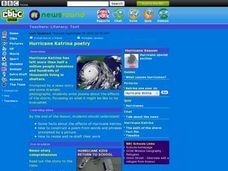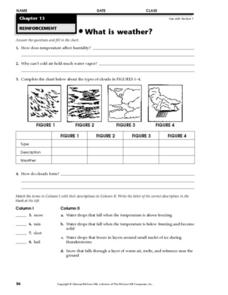Curated OER
Hurricane Katrina Poetry
Students write poems about the effects of a storm. Students study on what it might be like to be excavated. Students explore on how to revise and re-draft their work. Students construct a poem from words and phrases prompted by a picture.
Curated OER
Big on Blubber: How do Whales Stay Warm?
Students explore biology by conducting a science experiment in class. In this whale anatomy lesson, students identify the use of whale blubber for the animal to stay warm in cold waters while utilizing ice, vegetable oil, plastic bags...
Curated OER
Understanding Thunderstorms
In this thunderstorm worksheet, students read about thunder and lightning and the forces behind both. They also read about the timing difference between thunder and lightning. Students answer three critical thinking questions about...
Curated OER
Forces of Nature Vocabulary Quiz
In this science worksheet, students draw lines to match 13 words pertaining to forces of nature to their definitions in another column. Example: tornado, tide, erosion, pressure.
Curated OER
This Life Stinks
Students study how organisms that live in cold seep communities get energy from methane. In this organism lesson students write a brief report and identify oxidation reduction reactions and explain if these are dependent of...
Curated OER
What is Weather II?
In this weather learning exercise, students explain how temperature affects the humidity in weather. Then they complete a chart about the different types of clouds seen in the sky. Students also describe how clouds form and why.
Curated OER
Make it Rain!
Students describe how water exists on earth in three states. They trace the path that rain water follows after it falls. Students describe various forms that water takes on the earth's surface and conditions under which they exist....
Curated OER
Understanding Cloud Formation
Students read and relate the poem, "Clouds" by Aileen Fisher to a demonstration on cloud formation. They create clouds in jars using ice water and matches then discuss the ways clouds can be used to predict weather.
Curated OER
Phenomenal Weather-Related Statistics
Eighth graders research, collect and interpret data about weather statistics. They record that data on spreadsheets. they create Powerpoint presentations on their individual or group research.
Curated OER
Introduce Vocabulary: Fly Away Home (Bunting)
Approach a difficult subject with budding readers through Eve Bunting's story Fly Away Home, a child's perspective on homelessness. Focus on vocabulary in context, going over the terms learners will hear before reading...
Curated OER
Lord of the Rings - A Study of Tree Rings
Students examine trees and discuss how the environment effected the tree. They also predict what the area look like in fifty years.
Curated OER
Remote Sensing
Students research the Earth's ocean systems. They examine the impact of global warming on the oceans and the world as a whole.
Curated OER
In Harm's Way: Natural Disasters in My Community
Eleventh graders research and debate natural disasters that have occurred in their community. They assess whether these natural disasters were avoidable or were accidents. They investigate the extent of insurance coverage for disasters.
Curated OER
Geometric Series 2.3
Students will determine if a series of numbers are geometric, arithmetic, or neither and determine the common ratio if appropriate. In this geometric units lesson, students given a geometric series, determine the general term, and the...
Curated OER
Weather Words
Students brainstorm and define five terms for precipitation, discuss reasons why English language includes various terms for wet weather, and create word games such as jumbles, word searches, or crossword puzzles with weather terms.
Curated OER
What's in That Cake?
Cooperative groups research trip logs from deep-sea expeditions and explore characteristics of deepwater habitats. Using a cake as the ocean floor, they work together to decorate it as a model of such habitats. They also prepare a...
Curated OER
Saturn
Looking for a good worksheet to help teach about the planet Saturn? This worksheet is for you! An excellent photograph of Saturn accompanies three paragraphs of text. Pupils answer five multiple choice questions based on what they've...
Scholastic
Leads in Narrative Writing
The beginning, a very good place to start, is also a very difficult thing to craft. Provide your writers with this handout that identifies, and provides examples of, six different types of narrative leads.
K12 Reader
Visual Clues
Whether you realize it or not, reading an image and reading a text require similar skills, including the ability to make inferences. For this simple worksheet, children look at a picture of a snowy winter day and answer a series of...
Super Teacher Worksheets
Types of Clouds
What's the term for clouds that look like fluffy cotton balls? What about thick, gray clouds? Learn the names and descriptions for each type of cloud with a worksheet and activity. Learners read four columns of high-level, mid-level,...
American Museum of Natural History
Climate Change
It actually is possible to have too much of a good thing when it comes to climate change. A slide show lesson describes how burning fossil fuels contributes to climate change. Individuals read about the scientific process and the...
NOAA
Why Should I Care?: Show How Increased Carbon Dioxide Makes the Ocean More Acidic
How does a change in pH affect the ocean ecosystem? Scholars explore the idea by making an acid-base indicator in part seven of the 10-installment Discover Your Changing World series. First, they explore impacts of carbon dioxide in...
K12 Reader
The Snow Blows
Brrr! It's cold outside when it snows. Have your class read this poem about the snow to practice the long /o/ sound, -ow words, and reading comprehension. After reading, they respond to three questions.
TLS Books
Jupiter
Young astronomers read an informational text on the gas giant, Jupiter. Then they answer four multiple choice questions based on what they read.























